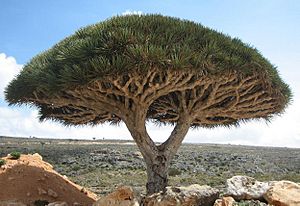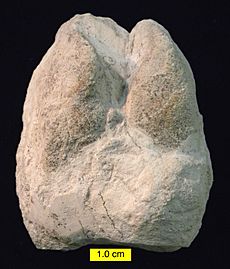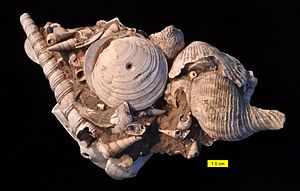Miocene facts for kids

The Miocene is the first epoch of the Neogene period of the Cainozoic. It started about 23 million years ago and ended about 5.33 million years ago. The rock beds that mark the start and end are well known, but the exact dates of the start and end of the period are uncertain. The biota becomes 'modern'.
The Miocene was named by Sir Charles Lyell. Its name comes from the Greek words μείων (meiōn, “less”) and καινός (kainos, “new”) and means "less recent", because it has 18% fewer modern sea invertebrates than the Pliocene.
As the earth cooled, it went from the Oligocene epoch, through the Miocene, and into the Pliocene. The Miocene boundaries are not set at any particular world wide event. They are set at regional boundaries between the warmer Oligocene and the cooler Pliocene epochs.
The plants and animals of the Miocene were fairly modern. Modern families of mammals and birds existed. Whales, seals, and kelp spread. Modern sharks appeared, including the huge Megalodon. Grasslands became more common. Mammalian browsers became less common, and grazer species became more common. About 100 species of ape lived at that time, and cetaceans were very common in the seas. The giganic shark Carcharodon megalodon may have preyed on them.
Life
Life during the Miocene Epoch was mostly supported by the two newly formed biomes, kelp forests and grasslands. Grasslands allow for more grazers, such as horses, rhinoceroses, and hippos. Ninety five percent of modern plants existed by the end of this epoch.
Flora
The coevolution of gritty, fibrous, fire-tolerant grasses and long-legged gregarious ungulates with high-crowned teeth, led to a major expansion of grass-grazer ecosystems, with roaming herds of large, swift grazers pursued by predators across broad sweeps of open grasslands, displacing desert, woodland, and browsers.
The higher organic content and water retention of the deeper and richer grassland soils, with long term burial of carbon in sediments, produced a carbon and water vapor sink. This, combined with higher surface albedo and lower evapotranspiration of grassland, contributed to a cooler, drier climate. C4 grasses, which are able to assimilate carbon dioxide and water more efficiently than C3 grasses, expanded to become ecologically significant near the end of the Miocene between 6 and 7 million years ago. The expansion of grasslands and radiations among terrestrial herbivores correlates to fluctuations in CO2.
Cycads between 11.5 and 5 m.y.a. began to rediversify after previous declines in variety due to climatic changes, and thus modern cycads are not a good model for a "living fossil". Eucalyptus fossil leaves occur in the Miocene of New Zealand, where the genus is not native today, but have been introduced from Australia.
Fauna
Both marine and continental fauna were fairly modern, although marine mammals were less numerous. Only in isolated South America and Australia did widely divergent fauna exist.
In the Early Miocene, several Oligocene groups were still diverse, including nimravids, entelodonts, and three-toed equids. Like in the previous Oligocene epoch, oreodonts were still diverse, only to disappear in the earliest Pliocene. During the later Miocene mammals were more modern, with easily recognizable canids, bears, procyonids, equids, beavers, deer, camelids, and whales, along with now extinct groups like borophagine canids, certain gomphotheres, three-toed horses, and semiaquatic and hornless rhinos like Teleoceras and Aphelops. Islands began to form between South and North America in the Late Miocene, allowing ground sloths like Thinobadistes to island-hop to North America. The expansion of silica-rich C4 grasses led to worldwide extinctions of herbivorous species without high-crowned teeth.
A few basal mammal groups endured into this epoch in southern landmasses, including the south american dryolestoid Necrolestes and gondwanathere Patagonia and New Zealand's Saint Bathans Mammal. Non-marsupial metatherians were also still around, such as the American and Eurasian herpetotheriids and peradectids such as Siamoperadectes, and the South American sparassodonts.
Unequivocally recognizable dabbling ducks, plovers, typical owls, cockatoos and crows appear during the Miocene. By the epoch's end, all or almost all modern bird groups are believed to have been present; the few post-Miocene bird fossils which cannot be placed in the evolutionary tree with full confidence are simply too badly preserved, rather than too equivocal in character. Marine birds reached their highest diversity ever in the course of this epoch.
Approximately 100 species of apes lived during this time, ranging throughout Africa, Asia and Europe and varying widely in size, diet, and anatomy. Due to scanty fossil evidence it is unclear which ape or apes contributed to the modern hominid clade, but molecular evidence indicates this ape lived between 7 and 8 million years ago. The first hominins (bipedal apes of the human lineage) appeared in Africa at the very end of the Miocene, including Sahelanthropus, Orrorin, and an early form of Ardipithecus (A. kadabba) The chimpanzee–human divergence is thought to have occurred at this time.
The expansion of grasslands in North America also led to an explosive radiation among snakes. Previously, snakes were a minor component of the North American fauna, but during the Miocene, the number of species and their prevalence increased dramatically with the first appearances of vipers and elapids in North America and the significant diversification of Colubridae (including the origin of many modern genera such as Nerodia, Lampropeltis, Pituophis and Pantherophis).
In the oceans, brown algae, called kelp, proliferated, supporting new species of sea life, including otters, fish and various invertebrates.
Cetaceans attained their greatest diversity during the Miocene, with over 20 recognized genera in comparison to only six living genera. This diversification correlates with emergence of gigantic macro-predators such as megatoothed sharks and raptorial sperm whales. Prominent examples are C. megalodon and L. melvillei. Other notable large sharks were C. chubutensis, Isurus hastalis, and Hemipristis serra.
Crocodilians also showed signs of diversification during Miocene. The largest form among them was a gigantic caiman Purussaurus which inhabited South America. Another gigantic form was a false gharial Rhamphosuchus, which inhabited modern age India. A strange form, Mourasuchus also thrived alongside Purussaurus. This species developed a specialized filter-feeding mechanism, and it likely preyed upon small fauna despite its gigantic size.
The pinnipeds, which appeared near the end of the Oligocene, became more aquatic. Prominent genus was Allodesmus. A ferocious walrus, Pelagiarctos may have preyed upon other species of pinnipeds including Allodesmus.
Furthermore, South American waters witnessed the arrival of Megapiranha paranensis, which were considerably larger than modern age piranhas.
New Zealand's Miocene fossil record is particularly rich. Marine deposits showcase a variety of cetaceans and penguins, illustrating the evolution of both groups into modern representatives. The early Miocene Saint Bathans Fauna is the only Cenozoic terrestrial fossil record of the landmass, showcasing a wide variety of not only bird species, including early representatives of clades such as moas, kiwis and adzebills, but also a diverse herpetofauna of sphenodontians, crocodiles and turtle as well as a rich terrestrial mammal fauna composed of various species of bats and the enigmatic Saint Bathans Mammal.
Oceans
There is evidence from oxygen isotopes at Deep Sea Drilling Program sites that ice began to build up in Antarctica about 36 Ma during the Eocene. Further marked decreases in temperature during the Middle Miocene at 15 Ma probably reflect increased ice growth in Antarctica. It can therefore be assumed that East Antarctica had some glaciers during the early to mid Miocene (23–15 Ma). Oceans cooled partly due to the formation of the Antarctic Circumpolar Current, and about 15 million years ago the ice cap in the southern hemisphere started to grow to its present form. The Greenland ice cap developed later, in the Middle Pliocene time, about 3 million years ago.
Images for kids
See also
 In Spanish: Mioceno para niños
In Spanish: Mioceno para niños







